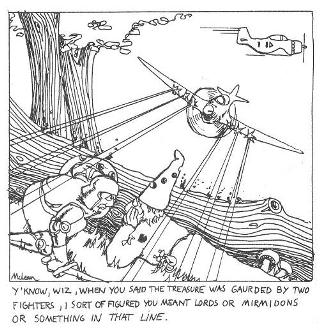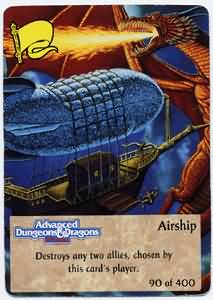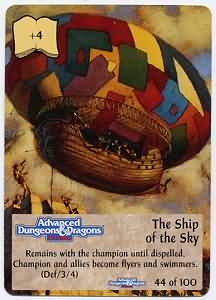
| Sailors on the Seas of Air | Gliders | Flying the Friendly(?) Skies | Aarakocra (PC race) | Kocraa -- God of the Aarakocra |
| Escrimador (PC class) | New Front-End Alignments | Spells of Odeen the Arch-Mage | Backpacks | Ecology: Gelatinous Cube |
| - | - | - | - | Dragon |

-
-
Dragon #244
Sailors
on the
Sea of Air
The skyships of the
FORGOTTEN REALMS™
campaign
by Ed Greenwood

Many classics of fantasy literature
describe flying ships — not spacecraft or
airplanes, but ships with sails, anchors,
and clipper hulls that sail gracefully
through the sky. A DM can
readily see that such skyships offer fasci-
nating AD?D® game possibilities —
as long
as one is careful to limit their dependabil-
ity and combat usefulness so that they do
not dominate play. A city or nation that
controls a fleet of airships may dominate
its neighbors, as happens in fantasy author
Lin Carter’s Thongor series. Herein the Air
Guard of Imperial Patanga rules most
battlefields. Likewise, in Carter’s Callisto
series, the Sky Pirates of Zanadar, City in
the Clouds, prey with impunity on the
riches of other lands. Much of Carter’s
writing is in the tradition established by
Edgar Rice Burroughs, who filled the skies
of John Carter’s Barsoom with gun-armed
airboats. Most of these novels lie properly
in the realm of space opera, but a few take
comfortable form in a fantasy setting.
Many fantasy authors, such as L. Frank
Baum in his Oz series, use balloons of
various sorts, while others (such as Walt
Disney, in his version of Barrie’s Peter Pan)
lift galleons intact and dripping from the
water into the sky by magic. (In Peter Pan,
magic is called “pixie dust,” and the subject
is simply left at that.)
Lin Carter deserves special mention
because he has taken the trouble to
explain the means by which his skyships
stay aloft. On Callisto, the skyships are
made of “miraculously tough and resilient
laminated paper” and have hollow double
hulls. A naturally buoyant gas is pumped
between the two hull layers, and a “com-
plicated system of cables and joints and
pulleys by which the jointed stationary
wings” are manipulated serves to propel
and steer such vessels. A cover illustration
depicts a high-pooped, three-masted gal-
leon with full sails, as well as two spread-
ing, bat-like wings. The vessels are
vulnerable to fire, catapulted stones, and
lesser missiles, such as arrows and hurled
javelins.
In The Black Star, Carter describes a
ship of Lemuria (perhaps one of the ships
of Thongor’s Patanga, mentioned above)
which survives in the later kingdom of
Atlantis. “The art of their manufacture
had perished millenia ago: viwan vidya, as
the science of the flying boats was called
in the old Lemurian tongue, was one of
the many casualties of time. In the dawn
of man, some old sorcerer of Lemuria the
Lost had first learned from the High Gods
the secret of the weightless metal,
urlium.”
In this case, the mirror-bright,
silvery metal was fashioned into a slim,
needle-pointed hull; within it were placed
engines powered by sithurls (“sun-stones”),
power crystals which draw, store, and
focus energy from sunlight. The engines
produce power for the rotors whose fan
blades propel the craft. At the tail of the
ship are adjustable vanes for steering the
ship; a compass (a glass sphere containing
a floating lodestone) is also included to aid
the ship’s captain. The story reveals that
one man can fly such a craft, and the
presence of the compass indicates that
urlium is not a ferrous, magnetic metal.
There are scores of other aerial craft in
the pages of fantastic fiction’, and for a
long time, I toyed with the idea of using
such vessels as Carter does in The Black
Star, — wherein his ship is a rarity and the
knowledge of its making is a lost art — in
AD?D game play in the Forgotten
Realms.
As usually happens when I procrastinate,
the Realms decided things for me. A letter
from Elminster the Sage arrived through
the gate in the woods. I quote the latter
part of it here:
“. . . In recent letters to me, the sorcer-
ess Laeral has revealed the simple princi-
ples of the skyship Vulathar Ravoenen,
constructed long ago by unknown artisans
in the land now known as Thay. It is (or
was) a sailing vessel — massive and broad
of beam so that it may rest upright and
intact upon reasonably level ground, but is
otherwise similar to a water vessel. It
partakes not of the rare or strange in its
construction, but rather makes much use
of the more flexible woods — willow and
the great palm — so as to give and flow
with the winds, and not to endlessly batter
against them. It has three masts of such
flexible wood, and two rigid panels that
are swung down from the sides of the
ship, turning on their pivots, to serve as
‘leeboard’ keels or steering vanes. In air, as
in water, these vanes prevent the ship
from being driven helplessly sideways by a
wind, propelling it forward as intended.
“While undamaged, the vessel can never
sink beneath the seas, for the same forces
that hold it aloft act upon the waves about.
The ship’s hull is studded with many plates
—polished tortoise-shell, I believe,
although Laeral gives the impression that
other substances will do — upon which
levitate spells of unusual strength and
duration have been cast. (Indeed, these
may be permanent, although Laeral does
mention that such ships are regularly
grounded for repairs, which may well
require the renewal of spells.) The ship’s
cargo is therefore restricted to that
amount which the magic will lift; this is
not, as compared to a seagoing vessel, a
very large amount. Such a skyship is also
subject to the vagaries of the winds, which
may be more perilously unpredictable
near rock faces than waves of water. Sky-
ships cannot hover in place unless there is
no breeze at all. Such a ship is anchored to
rocky spires by lines and mooring gaffs
(“angbraces”), or brought to the ground
and pegged down with its sails furled (a
rigged skyship can tear free of its lines
and run aloft in scant rounds if sufficient
wind arises).
“A flying ship of this nature is obviously
no steady-but-maneuverable fighting plat-
form; spells may be cast from its decks,
but it is a large and clumsy target in any
aerial battle [being maneuverability class
E], and has a great degree of variability in
speed and stability due to the caprice of
the winds and the turbulence created by
other aerial bodies. Still, these skyships
are effective in dropping solid missiles (or
such things as acid or flaming oil) upon
hostile forces. The buoyancy of such a
vessel is greatest close to the ground,
where the air is thickest. The maximum
height at which a skyship may be con-
trolled is 3600’, Laeral writes, so a skyship
must skirt the loftiest mountain peaks in a
manner much like that used by travelers
on the ground.
“The height at which the ship sails can
be crudely affected by the amount of
cargo onboard, but is also influenced
greatly by a magical rod home by the
captain. This rod of levitation is so con-
structed as to consist of three parts: the
central shaft and two short, hollow cylin-
ders which fit over the shaft and cover its
ends. The cylinders themselves have no
end caps. These endpieces are customarily
painted or carved with raised characters
to distinguish one from the other in dark-
ness. Both can be twisted like screws and
slid clown the shaft towards its center. As
a tip of the rod is revealed, its powers are
felt. One end of the rod augments the
levitate spells of the ship itself, so that it
rises steadily; the other dampens their
efficacy so that the ship loses altitude. The
power of both these effects are increased
as more of the desired end of the rod is
revealed. A ship can therefore dive or
climb with some alacrity if its captain is
dextrous and the rod is fully charged.
Laeral notes that these powerful rods
need continual recharging (although she
reveals nothing of the method by which
this is done). Laeral also notes that a skill-
ful individual using such a rod can leap off
precipices and land safely below (as if
using a feather fall spell), or descend from
a skyship to the ground below and there-
after ascend again. Using both grips of the
rod, the user may appear to walk on air
by tipping the rod’s ends alternately to
move sideways with an awkward hopping
motion.
“Regrettably, Laeral reveals too little of
the whereabouts or the creation of this
crucial element of a skyship — but she
does say that unless a wind or some other
force is acting upon a vessel’s altitude, it
remains at the height the rod puts it at
before being recovered. When a vessel
lacks such a rod, the long angbraces and
the sky-anchors (metal or rock claws
attached to strong lines, thrown at nearby
minarets, pinnacles, other vessels, or even
at flying beasts who pull the vessel higher
or lower) often suffice.
“Laeral states that one skyship of this
type carried her sisters — the ranger Dove
and the bard Storm Silverhand — and
herself from the doomed city of Myth
Drannor when they were infants, drop-
ping them on the Moonshae Isles before
scudding on westwards over the trackless
great sea. The ship, the Vulathor
Ravoenen, may yet survive, and there are
recent rumors of like vessels from as far
afield in the Realms as Calimshan in the
hot South, and Sossal in the farthest reach-
es of the Northeast, across the Great Gla-
cier. I cannot yet state in truth that such
vessels still exist, but they have existed,
and at least one person knows enough to
direct the successful construction of oth-
ers, should she wish to do so. From what I
know of Laeral’s sisters, they could also
handle all but the magic involved, and
there are others, especially among the
elves, who survived the fall of Myth Dran-
nor. So, my friend, I may yet have a ship
that sails the skies to show you. With
pleasure, I remain your willing servant,
Elminster of Shadowdale.”
Footnotes
1 Carter, Lin. Sky Pirates of Callisto. New
York: Dell Publishing Co., 1973, page 33.
This paperback is the third in the Callisto
series.
Ibid., page 32.
? Carter, Lin. The Black Star. New York:
Dell Publishing Co., 1973, page 37. “Viwan”
is the name of such a craft, equivalent to
“airboat” or “skyship.”
4 For example, Michael Moorcock’s War-
lord of the Air and its sequels, Poul Ander-
son’s A Midsummer Tempest, the works of
Otis Adelbert Kline, Neal Barrett, Jr.‘s
Aldair series, and Kenneth Bulmer’s Dray
Prescott series (written under the name
Alan Burt Akers).

26) One manager demanded zeppelins at one
point. I rolled my eyes and called Ed. He pointed out that he had already
done the Skyships of Halruaa for DRAGON about a year previous. I was pleased
to present that material to the manager.
- Realms
and Remembrance, by Jeff Grubb
?add the rolleyes gif>